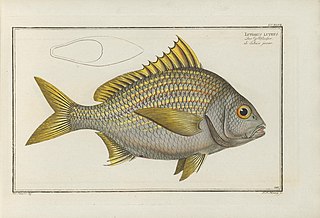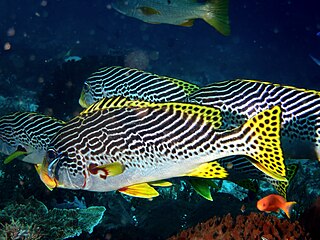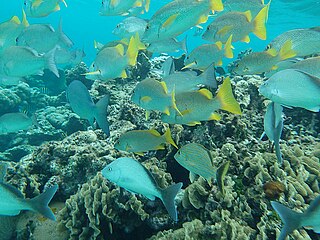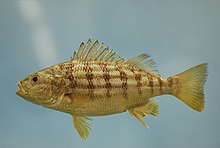
The Caesar grunt, also known as the black grunt, blacktail grunt, or redmouth grunt is a species of marine ray-finned fish, a grunt in the family Haemulidae. It is native to the western Atlantic Ocean.

The Indian Ocean oriental sweetlips, also known as the oriental sweetlips or oriental blubberlips, is a species of marine ray-finned fish, a sweetlips belonging to the subfamily Plectorhinchinae, one of two subfamilies in the family Haemulidae, the grunts. It is native to the Indian Ocean and the western Pacific Ocean.

Plectorhinchus pica, the painted sweetlips, dotted sweetlips, magpie sweetlips or spotted sweetlips, is a species of marine ray-finned fish, a sweetlips belonging to the subfamily Plectorhinchinae, one of two subfamilies in the family Haemulidae, the grunts. It is native to coral reefs of the Indian Ocean and the western Pacific Ocean. It is a commercially important species and can be found in the aquarium trade.

Haemulon flavolineatum, the French grunt, banana grunt, gold laced grunt, open-mouthed grunt, redmouth grunt, or yellow grunt, is a species of marine ray-finned fish, a grunt belonging to the family Haemulidae. It is native to the western Atlantic Ocean.

The bigeye grunt is a species of marine ray-finned fish, a grunt belonging to the family Haemulidae. It is native to the Atlantic coast of Africa.

Diagramma is a genus of marine ray-finned fishes belonging to the family Haemulidae, grunts native to the Indian Ocean and the western Pacific Ocean. The currently recognized species in this genus are:

Genyatremus luteus, the Torroto grunt, is a species of marine ray-finned fish, a sweetlips belonging to the subfamily Plectorhinchinae of the family Haemulidae. It is native to the Atlantic coast of South America from Colombia to Brazil.
The dara is a species of marine ray-finned fish, a grunt belonging to the family Haemulidae. It is native to the Atlantic coast of Africa. It is the only species in the monospecific genus Parakuhlia.

The Mexican barred snapper, also known as the barred pargo, is a species of marine ray-finned fish, a snapper belonging to the family Lutjanidae. It is native to the eastern Pacific Ocean. It is the only species in its genus.

Haemulon chrysargyreum, the smallmouth grunt, bronze grunt, or yellowstripe grunt, is a species of marine ray-finned fish, a grunt belonging to the family Haemulidae. It is found in the western Atlantic Ocean.

Pomadasys maculatus, commonly known as the saddle grunt, blotched grunt or blotched javelin, is a species of marine ray-finned fish, a grunt belonging to the family Haemulidae. It is native to the Indo-West Pacific region.

Pomadasys kaakan, the javelin grunter or barred javelin is a species of marine ray-finned fish, a grunt belonging to the family Haemulidae. It is native to the Indian and Pacific Oceans, from Africa to Australia.

Orthopristis chrysoptera, the pigfish, hogfish, piggy perch, redmouth grunt or sailor's choice, is a species of marine ray-finned fish, a grunt belonging to the family Haemulidae. It is found in the western Atlantic Ocean. This name derives from the grunting or chattering noise these fish make by rubbing their pharyngeal teeth together.

Plectorhinchus lineatus, also known as the yellowbanded sweetlips, oblique-banded sweetlips, diagonal-banded sweetlips, Goldman's sweetlips, lined blubber-lips, lined sweetlips, many-lined sweetlips, striped sweetlips and yellowband sweetlips, is a species of marine ray-finned fish, a sweetlips belonging to the subfamily Plectorhinchinae, one of two subfamilies in the family Haemulidae, the grunts. It inhabits coral reefs of the western Pacific Ocean, where it occurs at depths from 1 to 35 m.

Haemulon album, the white margate, grey grunt, grunt, Margaret fish, Margaret grunt, margate, margate fish, ronco blanco, viuda, white grunt, white pogret, or yellow grunt is a species of ray-finned fish, a large grunt belonging to the family Haemulidae. It is native to the western Atlantic Ocean.
Pomadasys macracanthus, the longspined grunt or Mexican gray perch, is a species of marine ray-finned fish, a grunt belonging to the family Haemulidae. It is native to the Eastern Pacific from Mexico to Ecuador.

Pomadasys argenteus, the silver grunt, silver javelin, grunter bream, small-spotted grunter-bream, small-spotted javelin fish, trumpeter or white-finned javelin fish, is a species of marine ray-finned fish, a grunt from the family Haemulidae. This species has a wide Indo-Pacific distribution. It is the type species of the genus Pomadasys.

The African striped grunt is a species of marine ray-finned fish, a sweetlips belonging to the subfamily Plectorhinchinae, one of two subfamilies in the family Haemulidae, the grunts. It is found in the eastern Atlantic Ocean.

Aphareus rutilans, the rusty jobfish, ironjaw snapper, red smalltooth job, silvermouth or small tooth jobfish, is a species of marine ray-finned fish, a snapper belonging to the family Lutjanidae. It is found in the Indo-Pacific region.

Lutjanus novemfasciatus, the Pacific cubera snapper or Pacific dog snapper, is a species of marine ray-finned fish, a snapper belonging to the family Lutjanidae. It is native to the eastern Pacific Ocean.



















